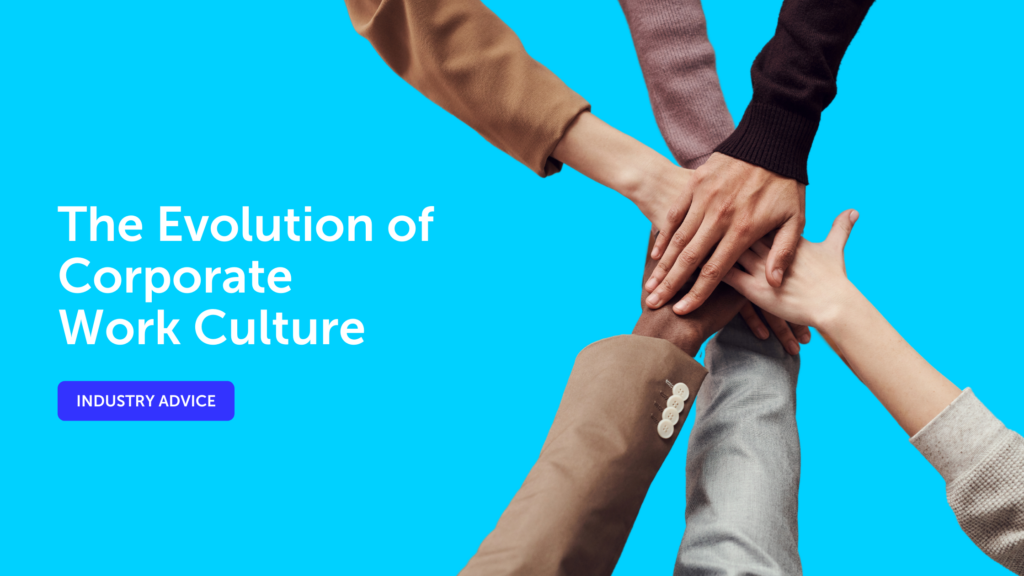Feel like your work life is stagnant or like you’re always working on the same thing? You are not alone. But despite how it may feel, changes to our broader work culture usually happen gradually. These changes aren’t always noticeable; sometimes we even have to exit a stage of career development before we realize what we were experiencing at the time.
Of course, all of this has changed during the COVID-19 pandemic, which caused the most rapid upheaval in work life in many generations. We’re still dealing with the aftershocks of the initial changes brought about by the pandemic, and as the pandemic continues to evolve, our collective work style and priorities are evolving along with it.
In this article, we’ll discuss how American work culture has evolved over the last 100 years or so, how it’s changed since the pandemic began, and what we might expect in the next few years.
The Beginning of Corporate Culture
As men returned from military service in the 1950s and 60s, American work culture began to shift. Improved communication technology allowed companies to grow and expand operations rapidly, and as they grew, they began to employ more people in what was the beginning of corporate culture. As televisions became more widely available, TV advertising exploded, as did consumer culture along with it. A growing American consumerism funded further growth in companies that produced and supplied goods. It was during this time that the typical 9-5 corporate schedule became widespread.
Early corporate culture was limited to educated white men. While women were expected to participate in the workforce during WWII, the return of troops set gender equality at work back some years, with many women returning to full-time housework and/or child-rearing. It was only around this time that college education for women became more commonplace.
Similarly, Black Americans and other people of color were excluded from corporate culture through limitations on access to education, as well as because of discrimination and prejudice.
Changes in the 1990s
After several decades of the expansion of corporate work culture, by the 1990s, white-collar jobs were relatively accessible and common. The accessibility of higher education and the introduction of anti-discrimination laws helped bring the career and financial opportunities of corporate work to more people. By this time, corporate culture was fully entrenched in our broader cultural conversation, and its values began to cross over and influence other aspects of public life.
Though the internet is beginning to become part of the corporate culture during this time, it still accounts for very little of the country’s overall economic output. Corporate work continues to be done entirely in person in offices across the country.
The Internet Age and Corporate Work Culture
After the dot com bubble burst in the early 2000s, interest rates were low enough to birth a new generation of entrepreneurs. This group founded some of the early, infamous startups, many of which still exist today as pillars of Silicon Valley culture. It is during this period that the internet became the foundation for most of the country’s economic activity. The internet also allowed some people to work from home, though at this point, this option was uncommon, and usually only offered by younger, more progressive employers.
Corporate culture evolved with popular social culture in becoming slightly more inclusive and offering better work conditions. Some startups, flush with cash from venture capital investments, famously invested in luxury perks like beer on tap in the office, company retreats, and free catered lunches. Meanwhile, the gap between benefits for corporate employees and benefits for blue-collar workers continued to expand.
COVID-19 and the New Era of Work
As we know, the rise of the COVID-19 pandemic changed the future of work almost overnight. Rising cases of coronavirus forced closures of most businesses that operated in-person. Many workers were either laid off or moved to virtual work with very little notice. When Pew Research conducted a survey in October of 2020, 71% of respondents reported that they were currently working from home. This compared to before the pandemic, when only 6% of people said they primarily worked remotely. While the move to remote work was initially thought to be temporary, a year and a half since the pandemic, many Americans are still working remotely. That begs the question: what exactly can we expect from the future of work and corporate culture?
Looking Ahead
It’s difficult to predict where exactly the pandemic will lead us from here. But there are a handful of indicators pointing to some interesting developments. Let’s get into what we can expect as things change over the next months and years.
More remote work
It looks like remote work is here to stay for the foreseeable future. Even as of April 2021, when many people were newly vaccinated against COVID, 72% of white-collar workers were still working remotely. A majority of people surveyed want to keep working remotely even after the pandemic is over, and with progress against the pandemic fluctuating month to month, it looks like they’ll get their wish.
Work-life balance
The stress of the pandemic and the associated economic upheaval, combined with challenging personal and professional expectations, have led to over half of survey respondents showing symptoms of burnout. Even more people were burned out by April 2021 than in 2020. Work is contributing to our collective stress, and as this widespread situation of burnout continues to evolve, we can expect workers pushing for better work-life balance.
E-commerce reigns
The pandemic pushed physical retailers to adapt to store closures and shoppers’ reluctance to shop in person. Even now, as the conditions of the pandemic have changed with widespread vaccination, 60% of people say they’re shopping in-person less than they were pre-pandemic. We expect this trend of e-commerce growth to continue to grow, even as we approach normalcy. A year and a half is plenty of time to develop a deep preference for online shopping.
Potential overcorrection back to in-person work
While all indicators do point to remote work continuing for the time being, there is a chance that at some point we’ll see an overcorrection of this trend. Once the pandemic truly becomes less of a threat, for example, we could see in-person work and especially in-person meetings becoming more common as people take advantage of the new freedom to meet without risk. If we see an overcorrection of this kind, it will likely be a temporary blip in a larger-scale, consistent move to more remote work.
Standard benefits
We’re seeing social pushback against the inequalities of benefits offered to workers of different kinds, especially since the pandemic began, emphasizing the different risks borne by blue-collar and white-collar workers. Whether or not current legislation manages to standardize childcare, education, and paid leave benefits, culturally, we are trending towards better benefits for everyone.
As much as we may try to predict the future of corporate culture based on current indicators, if the pandemic has shown us anything, it’s that we never truly know what’s coming. The best way to keep your company prepared is to be agile and hire great talent. A qualified team can help your business weather any storm. That’s why we’re proud to help some of the country’s largest companies hire the best people. For more details on how we can help, reach out to one of our recruiters today.








